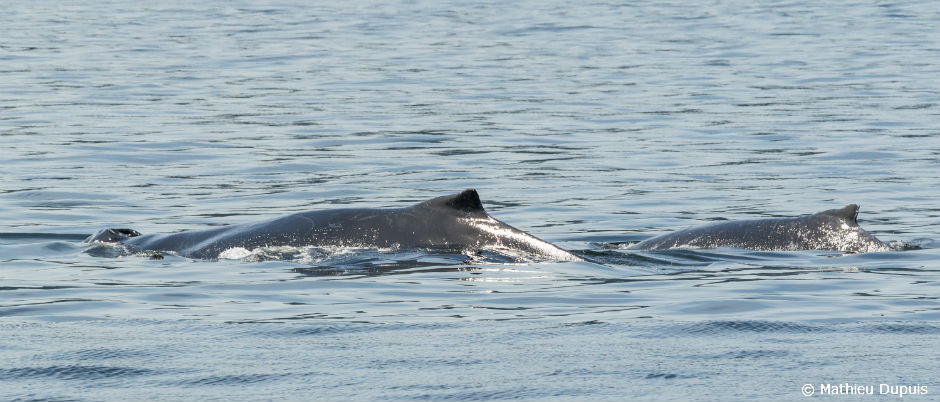The Québec maritime Blog

- Mathieu Dupuis
10 Things You May Not Know about Whales
Whales spend most of their lives underwater. They can be white, mottled, grey, blue or black and have teeth or baleen… You’ll be amazed by the diversity of cetaceans! Here are 10 interesting facts about whales.
1. Although they only live in water, whales are mammals, not fish

Like humans, whales have skin, and not scales. Some species even have hair! Unlike most fish, whales are warm-blooded. They must also come up to the surface to breathe. When they swim, they move up and down in the water (unlike fish that move sideways). Note that sharks, even the whale shark, are not part of the cetacean family (and thus are not mammals).
2. Whales nurse for the first months of their lives

Like all mammals, whales nurse their young before they eat solid food. Female whales have two mammary glands, hidden in mammary slits, which are located on either side of the genital opening near the tail. Whale milk is rich in fat: depending on the species, it has a fat content of 13% to 53%, which helps the calves gain weight rapidly.
3. Whales don’t chew their food

It’s true: whales swallow their prey whole! Even killer whales, which eat other whales, don’t chew their food. Whether they have teeth or baleen, whales’ digestive systems break down their food. Toothed whales do use their teeth to capture prey and may also use them to fight or communicate by touch, but teeth do not seem to be essential. Toothed whales have been known to survive without any teeth.
4. Whales don’t drink water

Even though they live in water, whales don’t drink it. They stay hydrated by metabolizing the water found in the food they eat. Cetaceans therefore don’t need to drink seawater to meet their water needs but may do so from time to time.
5. Whales can’t breathe through their mouths

Unlike humans, whales cannot breathe through their mouths since their digestive systems are not linked to their respiratory systems. They can only breathe through their blowholes, which are located at the top of their heads. (Note that toothed whales have one blowhole, while baleen whales have two.)
6. Only half of a whale’s brain sleeps at a time

Since whales are conscious breathers, they must remember to come up to the surface to breathe, even while sleeping. To avoid drowning, only half of their brains can sleep at a time. If you see a whale floating like a log near the surface of the water, it’s probably sleeping. (This behaviour is known as “logging.”)
7. All of the St. Lawrence whales migrate during the winter

Even belugas, which live in the St. Lawrence year-round, change their habitat for the winter by migrating towards the gulf. Where do other species go? Some head out to sea; for example, humpbacks gather in the Caribbean in the winter. However, their migration patters are still not well known: it’s hard to follow the underwater movement of whales over thousands of kilometres!
8. Whale earwax reveals an animal’s age

Unlike humans who clean out the wax that covers their ear canals, whales accumulate earwax plugs during their entire lives. About every six months a new layer of wax covers the previous layer. Researchers can read these layers like tree rings, using them to establish a whale’s age and health as well as assess the quality of its external environment at any time over the course of its life.
9. Many whales species form lasting social relationships

Toothed whales have complex social structures. For example, male belugas develop stable associations that last for many years. Male killer whales stay with their mothers for their entire lives. Sperm whales form groups called clans. Bonds are less important to baleen whales; however, pairs of female humpbacks have been observed together year after year in the St. Lawrence during the summer.
10. Whales play an essential role in the health of the planet

While whales are prey for certain species, they are mostly predators at or near the top of the food chain. Once they have fed, their fecal matter provides nutrients to phytoplankton, which feed fish, which feed whales, and the cycle goes on. When whales die, their carcasses sink to the bottom of the ocean and serve as food to scavenger organisms that decompose them. A whole ecosystem will develop on a whale carcass, which may last for nearly 100 years!
There are so many more things to learn about these fascinating marine mammals! To find out more, visit the Marine Mammal Interpretation Centre (CIMM) in Tadoussac, the Mingan Island Cetacean Study (MICS) in Longue-Pointe-de-Mingan or the Skeleton Museum in Notre-Dame-des-Sept-Douleurs.

(1) comment
Anne-Marie Dubois
Tres interessant. Continuer votre beau travail!